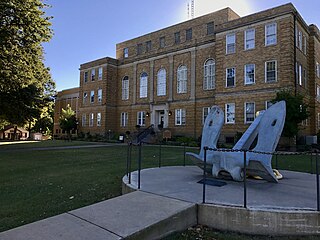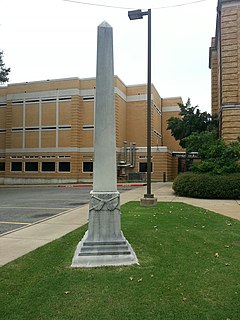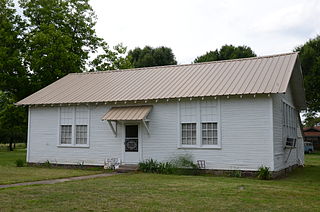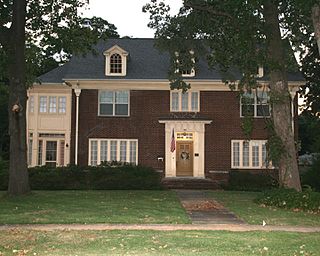
Faulkner County is located in the Central Arkansas region of the U.S. state of Arkansas. As of the 2010 census, the population was 113,237, making it the fifth most populous of Arkansas's 75 counties. The county seat and largest city is Conway. Faulkner County was created on April 12, 1873, one of nine counties formed during Reconstruction, and is named for Arkansas Militia Colonel Sandy Faulkner, a popular figure in the state at the time.

Morrilton is a city in Conway County, Arkansas, United States, less than 50 miles (80 km) northwest of Little Rock. The city is the county seat of Conway County. The population was 6,767 at the 2010 census.

Hillcrest Historic District is a historic neighborhood in Little Rock, Arkansas that was listed on the National Register of Historic Places on December 18, 1990. It is often referred to as Hillcrest by the people who live there, although the district's boundaries actually encompass several neighborhood additions that were once part of the incorporated town of Pulaski Heights. The town of Pulaski Heights was annexed to the city of Little Rock in 1916. The Hillcrest Residents Association uses the tagline "Heart of Little Rock" because the area is located almost directly in the center of the city and was the first street car suburb in Little Rock and among the first of neighborhoods in Arkansas.

U.S. Route 64 is a U.S. highway running from Teec Nos Pos, Arizona east to Nags Head, North Carolina. In the U.S. state of Arkansas, the route runs 246.35 miles (396.46 km) from the Oklahoma border in Fort Smith east to the Tennessee border in Memphis. The route passes through several cities and towns, including Fort Smith, Clarksville, Russellville, Conway, Searcy, and West Memphis. US 64 runs parallel to Interstate 40 until Conway, when I-40 takes a more southerly route.

Arkansas Highway 365 is a north–south state highway in Central Arkansas. The route of 69.31 miles (111.54 km) runs from US 65B/US 79B in Pine Bluff north through Little Rock to US 65B/AR 60 in Conway. The route is a redesignation of former U.S. Route 65, which has since been rerouted onto various Interstate highways through the area. Portions of Highway 365 in Jefferson County are former alignments of the Dollarway Road, which was the longest paved concrete road upon completion in 1913.

The Wilson Park Historic District is a historic district in Fayetteville, Arkansas, USA, located just northeast of the University of Arkansas. The district consists of several residential buildings that developed during the late 19th and early 20th Century near Wilson Park just north of Dickson Street, the city's primary entertainment district. Wilson Park Historic District includes 47 contributing buildings.

The North Elm Street Historic District is a predominantly residential historic district in Hope, Arkansas. The district is rectangular in shape, roughly bounded on the north by Avenue G, on the west by Hervey Street, on the east by Hazel Street, and on the south by the railroad tracks. Most of the residential structures in this area were built between 1890 and 1945, and represent the city's greatest concentration of homes built during its boom years. The only major institutional building in the district is Hope City Hall, a Classical Revival structure.

The Beech Street Historic District is a large residential historic district on the west side of the Helena section of Helena–West Helena, Arkansas. The district's spine is Beech Street, extending roughly from Phillips Street in the south to McDonough Street in the north, and widens out to include about three blocks each of College, Poplar, and Columbia Streets at its northern end. The district has long been a fashionable residential area of Helena, and includes a well-preserved diversity of residential architecture, dating from 1858 to 1935, with the Colonial Revival predominating. It includes 133 buildings, of which about 80 are historically significant. These properties are generally set on larger lots with attractive terraced landscaping.

The Bentonville West Central Avenue Historic District is a residential historic district west of the center of Bentonville, Arkansas. Located along West Central Avenue between A and G Streets stand forty houses, most of which were built between 1885 and 1935. They represent a concentration of the finest residential architecture of the period in the city. The houses are stylistically diverse, including two Italianate houses and six Craftsman houses. Notable among the former is the Craig-Bryan House, a brick structure that also has Gothic vergeboard decoration.

The Conway Commercial Historic District encompasses the historic commercial heart of Conway, Arkansas. The area, roughly bounded by Main Street on the south, Harkrider and Spencer Streets on the east, just south of Mill Street to the north, and Locust Street to the west, was developed between 1879 and 1960, and includes representative architecture from four major phases of the city's development. It includes the city's oldest commercial building, the 1879 Frauenthal & Schwarz Building.

The Conway Confederate Monument stands on the lawn of the Faulkner County Courthouse, east of the junction of Robinson Avenue and Center Street in Conway, Arkansas. It is a stone obelisk, 200 inches (5.1 m) in height, with a square base 45 inches (1.1 m) on each side. The east face bears the inscription "1861-65 / / DEDICATED TO THE MEMORY / OF OWR CONFEDERATE SOLDIERS / THE BRAVEST OF THE BRAVE / ERECTED BY / ROBERT E. LEE CHAPTER / NO. 718 U.D.C. / OCT. 1925". The monument was funded by the local chapter of the United Daughters of the Confederacy and was dedicated in 1925.

The Harton House is a historic house at 1821 Robinson Avenue in Conway, Arkansas. It is a large, irregularly massed 2-1/2 story wood frame house with a hip roof and clapboard siding. The roof is studded with cross gables exhibiting a half-timbered appearance, and a single-story porch wraps around the front and side, supported by brick piers. Built in 1890, the house is a distinctive combination of Queen Anne and Colonial Revival styling. It was built for D. O. Harton, a prominent local businessman.

The Hendrix College Addition Neighborhood Historic District encompasses a predominantly residential area of Conway, Arkansas that was developed in the first half of the 20th century. Located just north of the Hendrix College campus, it is an area of about 40 acres (16 ha) and twelve square blocks, bounded on the south by Winfield Street, the west by Washington Avenue, the east by Harkrider Street, and the north by Fleming Street. Architecturally, the houses in the neighborhood represent a cross-section of styles popular in the period, from the Prairie School and English Revival, to post-World War II ranch houses. The land had been acquired by Hendrix College when it relocated to Conway in the 1890s, and was developed as a way to pay off some of the debts incurred because of the move. It was one of the city's first formally platted subdivisions.

The Lasley's College Apartments are a historic apartment complex at 1916 and 1922 Bruce Street in Conway, Arkansas, adjacent to the campus of the University of Central Arkansas. It consists of two two-story brick buildings flanking a central courtyard. Each building has a flat roof with parapet, and houses eight residential units, four one-bedroom and four two-bedroom units in each. They were built in 1947 in response to the university's increasing demand for housing, and are a well-preserved example of period multiunit residential architecture.

The Liberty School Cafeteria is a historic school building in rural Faulkner County, Arkansas. It is located on the west side of Arkansas Highway 36, about 0.25 miles (0.40 km) north of its junction with United States Route 64, about midway between Conway and Vilonia. It is a modest single-story wood frame structure, with a gabled roof that has exposed rafter ends in the American craftsman style. It was built in 1935 with funding support from the Works Progress Administration, and originally housed classrooms for science, agriculture and math, as part of a consolidated regional primary school. In the 1940s it was converted into a cafeteria. The school district was further consolidated with Vilonia in the 1950s and 1960s, when this building's school function ceased. The grounds are now used for a flea market.

The Frank E. Robins House is a historic house at 567 Locust Street in Conway, Arkansas. It is a 2-1/2 story wood frame structure, most of its exterior finished in brick veneer. It has a gabled roof pierced by gabled dormers, and an enclosed two-story porch extending to the left. The front entrance is framed by pilasters and topped by an entablature and deep cornice with supporting brackets. The house was built in 1922 for a prominent local newspaper publisher who also served as Conway's mayor.

The S.G. Smith House is a historic house at 1937 Caldwell Street in Conway, Arkansas. It is a two-story brick structure, with a hip roof, and a porte-cochere extending to the west, supported by Tuscan columns. The main entrance is framed by Classical pillars supporting an entablature, and there is a round-arch window with narrow metal balcony to its right. The house was built about 1924 to a design by the Arkansas firm of Thompson and Harding.

The Moose Addition Neighborhood Historic District encompasses the oldest residential area of Morrilton, Arkansas. This area was farmland until the railroad was built through the region in the 1880s. Located just south of the railroad and the city's business district, this area was soon built up as a residential area, with most of its development coming between roughly 1925 and 1960. There is a single Queen Anne Victorian, built in 1881, from the earliest days of its development.

The West Church Street Historic District encompasses a collection of the finest late-19th and early-20th century homes in Morrilton, Arkansas. The district extends along West Church Street between South Morrill and South Cherokee Streets, and includes 23 primary buildings. All are houses, and include buildings from the earliest days of the city through the 1920s. The majority of the district's houses were built between 1926 and 1942, and are mainly Craftsman in style.

The Scull Historic District encompasses two concrete-block houses at 428 and 432 Conway Boulevard in Conway, Arkansas. These two houses were built about 1928, using a style of ornamental concrete block that were a fashionable building material during the 1920s. Both are single-story structures, with hip roofs and four-column porches recessed under the roof. The houses were probably built by Ferdinand Lawrence Scull, a local manufacturer of the ornamental blocks used in their construction.






















